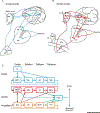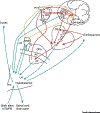Hypothalamic Interactions with Large-Scale Neural Circuits Underlying Reinforcement Learning and Motivated Behavior
- PMID: 32762959
- PMCID: PMC7483858
- DOI: 10.1016/j.tins.2020.06.006
Hypothalamic Interactions with Large-Scale Neural Circuits Underlying Reinforcement Learning and Motivated Behavior
Abstract
Biological agents adapt behavior to support the survival needs of the individual and the species. In this review we outline the anatomical, physiological, and computational processes that support reinforcement learning (RL). We describe two circuits in the primate brain that are linked to specific aspects of learning and goal-directed behavior. The ventral circuit, that includes the amygdala, ventral medial prefrontal cortex, and ventral striatum, has substantial connectivity with the hypothalamus. The dorsal circuit, that includes inferior parietal cortex, dorsal lateral prefrontal cortex, and the dorsal striatum, has minimal connectivity with the hypothalamus. The hypothalamic connectivity suggests distinct roles for these circuits. We propose that the ventral circuit defines behavioral goals, and the dorsal circuit orchestrates behavior to achieve those goals.
Keywords: amygdala; basal ganglia; devaluation; frontal-striatal circuits; hypothalamus; motivation; prefrontal cortex; reinforcement learning; striatum.
Published by Elsevier Ltd.
Figures


References
-
- Neftci EO and Averbeck BB (2019) Reinforcement learning in artificial and biological systems. Nature Machine Intelligence 1, 133–143.
-
- Averbeck BB and Costa VD (2017) Motivational neural circuits underlying reinforcement learning. Nature Neuroscience 20(4), 505–512. - PubMed
-
- Murray EA et al. (2017) The evolution of memory systems: ancestors, anatomy, and adaptations, First Edition edn., Oxford University Press.
-
- Hull CL (1943) Principles of behavior, an introduction to behavior theory, D. Appleton-Century Company.
-
- Toates FM (1986) Motivational systems, Cambridge University Press.
Publication types
MeSH terms
Grants and funding
LinkOut - more resources
Full Text Sources

